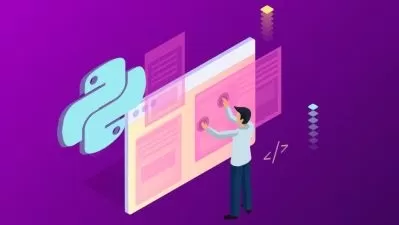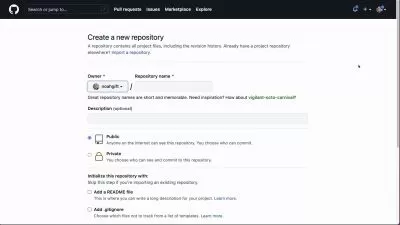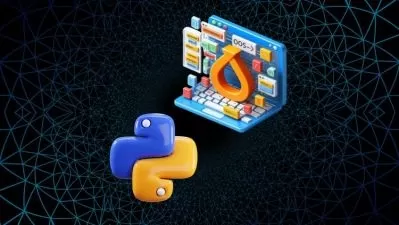Python - The Practical Guide
Academind by Maximilian Schwarzmüller,Maximilian Schwarzmüller
16:23:23
Description
Learn Python from the ground up and use Python to build a hands-on project from scratch!
What You'll Learn?
- Students can take advanced Python courses and build real projects with it
- Students may build upon the Python and Blockchain knowledge gained in this course and start working on their own Blockchain
- Students can dive into Web Development or Data Science with Python
Who is this for?
What You Need to Know?
More details
DescriptionWant to learn Python "on the job" whilst building an exciting course project? This course is for you!
This is a highly practice-oriented Python course that teaches you Python from scratch - no prior programming experience required!
Python is THEÂ most trending programming language you can learn these days!
It's very popular because it's easy to learn and use, runs on all operating systems and allows you to build a broad variety of programs:Â Be that web applications, desktop applications, utility scripts or using it for data science and machine learning.
In this course, you'll learn Python from scratch - and you'll do so whilst building your own Blockchain and Cryptocurrency. These are of course also highly trending topics and not a lot of people understand what a Blockchain really is. As a nice side-effect, you will know how a Blockchain works once you completed this course. It's an exciting course project that allows you to learn and apply Python to something you know and you can use.
Why Python?
As written above, Python is both easy-to-use and extremely versatile and powerful at the same time. Certainly not the worst combination. If you check it on Google trends (and compare it to other programming languages), you'll see that it's very popular these days.
It's being used by almost any important company - be that Google, Amazon or Facebook. It's used to run web applications, scripts, desktop programs and machine learning algorithms. This course sets the basics for all these use-cases!
Why Blockchain?
I believe that you learn something best if you directly apply it to a real-world project. And the Blockchain technology is an exciting trend which is there to stay. In this course, you'll learn a lot about the core concepts of the Blockchain and you'll see how Python can be used for the many aspects that make up a Blockchain and Cryptocurrency.
In my opinion, a perfect course project is challenging, interesting, something you know from real-life but also not overly complex. And that's all the case for the Blockchain! It poses some nice challenges where a lot of different Python features can be used to overcome them. It also is something we hear about all the time and yet no one knows how it works. And we can dive into the core Blockchain concepts without spending 100+ hours working on it.Â
Who's teaching you?
My name is Maximilian Schwarzmüller and I'm a freelance developer. My focus is on web development but I've been working with Python for many years. It's actually one of the first languages I started with when I was 13. I'm the creator of many 5 star bestseller courses here on Udemy and I love diving into new technologies. That's why I had to dive into this whole Blockchain thing when it became more popular and why I chose it as a project for this course.
I can't wait to welcome you on board of this course and I hope you'll enjoy it just as much as I did creating it! :-)
What's in the course?
Great question! Here's a brief summary:
A summary of Python and the Blockchain technology
All the base Python syntax you need to know (variables, operators, functions, ...)
Loops and conditional statements
More complex data structures like tuples or dictionaries
AÂ closer look at built-in functions and the standard library Python ships with
String manipulation
How to work with files
Error handling
Debugging
Object-oriented programming with classes and inheritance
Internal &Â external modules (packages)
How to spin up an Http server with the Flask package
Handling Http requests (sending & receiving)
And more!
What are the course prerequisites?
NOÂ prior programming knowledge is required
Very basic knowledge about how a computer works will help you though (but can also be built up whilst you're going through the course)
Is this course for you?
It's for you if
You want to get into programming =>Â Python is a great "first language" since it's easy to learn and very versatile
You want to broaden your horizon => Are you a web developer? Want to learn something new? Here you go!
You're interested in Python for web development =>Â This course will teach you Python in general but there are two modules where we'll also dive into web development a bit
You're interested in the Blockchain technology => You'll learn the core concepts of it as a side-effect of this course!
You know Python but want to practice it =>Â The course project is challenging and taken from real-life - there probably is no better practice
Does that sound good to you? I'd be honoured to welcome you in this course! :-)
Who this course is for:
- Anyone interested in learning Python and building a real project with it
- Anyone who's interested in learning about the core internals of a blockchain
- Beginner developers who want to dive into one of the most trending and popular programming languages
Want to learn Python "on the job" whilst building an exciting course project? This course is for you!
This is a highly practice-oriented Python course that teaches you Python from scratch - no prior programming experience required!
Python is THEÂ most trending programming language you can learn these days!
It's very popular because it's easy to learn and use, runs on all operating systems and allows you to build a broad variety of programs:Â Be that web applications, desktop applications, utility scripts or using it for data science and machine learning.
In this course, you'll learn Python from scratch - and you'll do so whilst building your own Blockchain and Cryptocurrency. These are of course also highly trending topics and not a lot of people understand what a Blockchain really is. As a nice side-effect, you will know how a Blockchain works once you completed this course. It's an exciting course project that allows you to learn and apply Python to something you know and you can use.
Why Python?
As written above, Python is both easy-to-use and extremely versatile and powerful at the same time. Certainly not the worst combination. If you check it on Google trends (and compare it to other programming languages), you'll see that it's very popular these days.
It's being used by almost any important company - be that Google, Amazon or Facebook. It's used to run web applications, scripts, desktop programs and machine learning algorithms. This course sets the basics for all these use-cases!
Why Blockchain?
I believe that you learn something best if you directly apply it to a real-world project. And the Blockchain technology is an exciting trend which is there to stay. In this course, you'll learn a lot about the core concepts of the Blockchain and you'll see how Python can be used for the many aspects that make up a Blockchain and Cryptocurrency.
In my opinion, a perfect course project is challenging, interesting, something you know from real-life but also not overly complex. And that's all the case for the Blockchain! It poses some nice challenges where a lot of different Python features can be used to overcome them. It also is something we hear about all the time and yet no one knows how it works. And we can dive into the core Blockchain concepts without spending 100+ hours working on it.Â
Who's teaching you?
My name is Maximilian Schwarzmüller and I'm a freelance developer. My focus is on web development but I've been working with Python for many years. It's actually one of the first languages I started with when I was 13. I'm the creator of many 5 star bestseller courses here on Udemy and I love diving into new technologies. That's why I had to dive into this whole Blockchain thing when it became more popular and why I chose it as a project for this course.
I can't wait to welcome you on board of this course and I hope you'll enjoy it just as much as I did creating it! :-)
What's in the course?
Great question! Here's a brief summary:
A summary of Python and the Blockchain technology
All the base Python syntax you need to know (variables, operators, functions, ...)
Loops and conditional statements
More complex data structures like tuples or dictionaries
AÂ closer look at built-in functions and the standard library Python ships with
String manipulation
How to work with files
Error handling
Debugging
Object-oriented programming with classes and inheritance
Internal &Â external modules (packages)
How to spin up an Http server with the Flask package
Handling Http requests (sending & receiving)
And more!
What are the course prerequisites?
NOÂ prior programming knowledge is required
Very basic knowledge about how a computer works will help you though (but can also be built up whilst you're going through the course)
Is this course for you?
It's for you if
You want to get into programming =>Â Python is a great "first language" since it's easy to learn and very versatile
You want to broaden your horizon => Are you a web developer? Want to learn something new? Here you go!
You're interested in Python for web development =>Â This course will teach you Python in general but there are two modules where we'll also dive into web development a bit
You're interested in the Blockchain technology => You'll learn the core concepts of it as a side-effect of this course!
You know Python but want to practice it =>Â The course project is challenging and taken from real-life - there probably is no better practice
Does that sound good to you? I'd be honoured to welcome you in this course! :-)
Who this course is for:
- Anyone interested in learning Python and building a real project with it
- Anyone who's interested in learning about the core internals of a blockchain
- Beginner developers who want to dive into one of the most trending and popular programming languages
User Reviews
Rating
Academind by Maximilian Schwarzmüller
Instructor's CoursesMaximilian Schwarzmüller
Instructor's Courses
Udemy
View courses Udemy- language english
- Training sessions 204
- duration 16:23:23
- English subtitles has
- Release Date 2024/04/23











